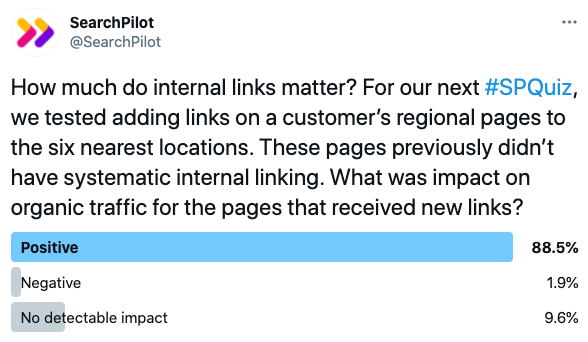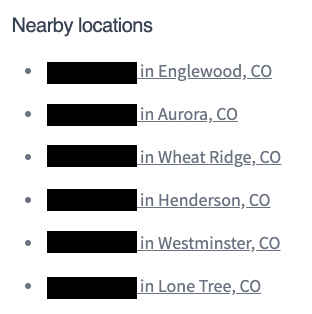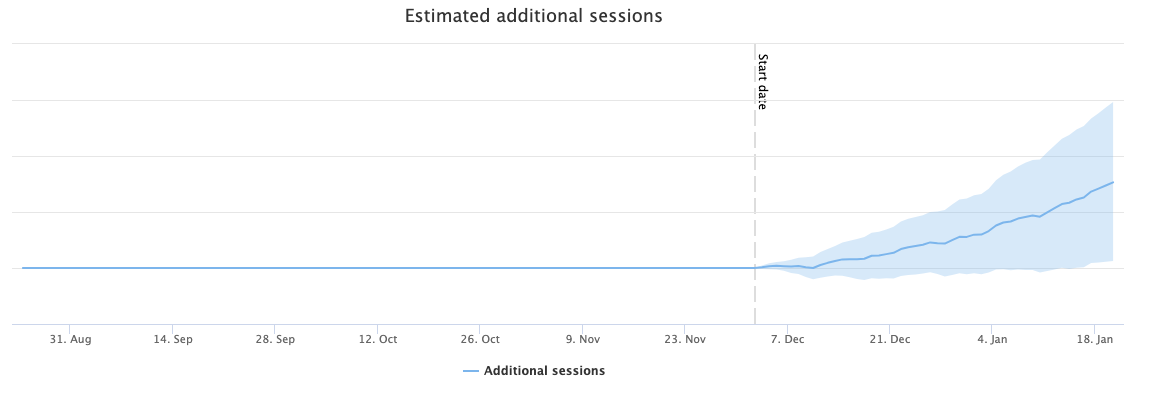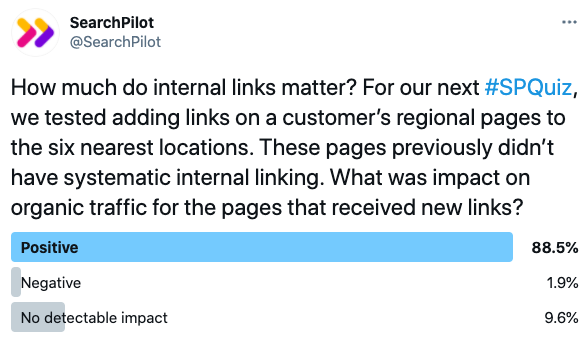Start here: how our SEO split tests work
If you aren't familiar with the fundamentals of how we run controlled SEO experiments that form the basis of all our case studies, then you might find it useful to start by reading the explanation at the end of this article before digesting the details of the case study below. If you'd like to get a new case study by email every two weeks, just enter your email address here.
This week’s #SPQuiz on Twitter asked our followers what they thought would happen when we added links to nearby locations on a website with a large number of location pages:

This one was a landslide! Internal linking is clearly believed to be an important contributor to SEO performance, as the vast majority of our followers thought this test would have a positive impact.
And they were right! Read on for the details, but this test showed a 7% improvement to the pages we added internal links to.
The Case Study
Many websites have a large number of location pages. For example, a real estate website with property listings organized by location; a job site that lets you search by location; a site for a company with a large number of physical locations - the list goes on.
These pages can often spiral in number in order to capture the demand for people searching for services in their location, which can cause various challenges for SEO. A large number of pages can cause issues with crawl budget and indexation, and these pages can struggle to receive sufficient internal link equity to perform well in search. A well-designed internal linking structure can benefit all of these aspects.
The particular website this test relates to has around 8,000 ‘regional’ pages across the USA, each of which lists the nearby physical company locations in that geographic area. Before the test began, some of these pages received internal links via breadcrumbs from the individual location pages, and some other sporadic links around the site, but there was no systematic internal linking in place.
To improve the internal linking, and therefore the distribution of link equity around these pages (and hopefully the pages’ organic search performance), we decided to test adding links from each regional page to the six nearest neighbouring regional pages. We wanted to run a controlled test, so instead of linking to all 8,000 pages, we first split them into two groups (control and variant), and only linked to the six closest pages within the variant group.
For example, on the Denver, Colorado page, we added the following links to other nearby cities:

Each of the pages we linked to was in the variant group. No new links were added that pointed to control pages. All location pages (control and variant) linked out to variant pages. This meant that, on average, each variant page was receiving twelve additional internal links.
The below chart shows the impact of this test on organic traffic for the linked-to pages, compared to the control pages which didn’t receive any links:

This corresponded to a 7% uplift in organic traffic.
It’s reassuring to know that SEO basics still work! These pages were starved of link equity, and adding internal links helped deliver equity, and therefore a boost in organic traffic. As a result, we amended the link blocks to point to all location pages, not just the variant group.
How our SEO split tests work
The most important thing to know is that our case studies are based on controlled experiments with control and variant pages:
- By detecting changes in performance of the variant pages compared to the control, we know that the measured effect was not caused by seasonality, sitewide changes, Google algorithm updates, competitor changes, or any other external impact.
- The statistical analysis compares the actual outcome to a forecast, and comes with a confidence interval so we know how certain we are the effect is real.
- We measure the impact on organic traffic in order to capture changes to rankings and/or changes to clickthrough rate (more here).
Read more about how SEO A/B testing works or get a demo of the SearchPilot platform.

